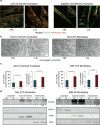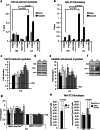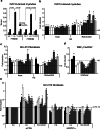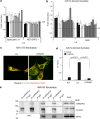A novel AMPK-dependent FoxO3A-SIRT3 intramitochondrial complex sensing glucose levels
- PMID: 23283301
- PMCID: PMC11113715
- DOI: 10.1007/s00018-012-1244-6
A novel AMPK-dependent FoxO3A-SIRT3 intramitochondrial complex sensing glucose levels
Abstract
Reduction of nutrient intake without malnutrition positively influences lifespan and healthspan from yeast to mice and exerts some beneficial effects also in humans. The AMPK-FoxO axis is one of the evolutionarily conserved nutrient-sensing pathways, and the FOXO3A locus is associated with human longevity. Interestingly, FoxO3A has been reported to be also a mitochondrial protein in mammalian cells and tissues. Here we report that glucose restriction triggers FoxO3A accumulation into mitochondria of fibroblasts and skeletal myotubes in an AMPK-dependent manner. A low-glucose regimen induces the formation of a protein complex containing FoxO3A, SIRT3, and mitochondrial RNA polymerase (mtRNAPol) at mitochondrial DNA-regulatory regions causing activation of the mitochondrial genome and a subsequent increase in mitochondrial respiration. Consistently, mitochondrial transcription increases in skeletal muscle of fasted mice, with a mitochondrial DNA-bound FoxO3A/SIRT3/mtRNAPol complex detectable also in vivo. Our results unveil a mitochondrial arm of the AMPK-FoxO3A axis acting as a recovery mechanism to sustain energy metabolism upon nutrient restriction.
Figures








Similar articles
-
SIRT3 interacts with the daf-16 homolog FOXO3a in the mitochondria, as well as increases FOXO3a dependent gene expression.Int J Biol Sci. 2008 Sep 5;4(5):291-9. doi: 10.7150/ijbs.4.291. Int J Biol Sci. 2008. PMID: 18781224 Free PMC article.
-
Arsenic Induces Insulin Resistance in Mouse Adipocytes and Myotubes Via Oxidative Stress-Regulated Mitochondrial Sirt3-FOXO3a Signaling Pathway.Toxicol Sci. 2015 Aug;146(2):290-300. doi: 10.1093/toxsci/kfv089. Epub 2015 May 15. Toxicol Sci. 2015. PMID: 25979314
-
AMPK promotes skeletal muscle autophagy through activation of forkhead FoxO3a and interaction with Ulk1.J Cell Biochem. 2012 Feb;113(2):695-710. doi: 10.1002/jcb.23399. J Cell Biochem. 2012. PMID: 22006269
-
FOXO3a from the Nucleus to the Mitochondria: A Round Trip in Cellular Stress Response.Cells. 2019 Sep 19;8(9):1110. doi: 10.3390/cells8091110. Cells. 2019. PMID: 31546924 Free PMC article. Review.
-
Regulation of mitochondrial function by forkhead transcription factors.Biochimie. 2022 Jul;198:96-108. doi: 10.1016/j.biochi.2022.03.013. Epub 2022 Mar 31. Biochimie. 2022. PMID: 35367579 Review.
Cited by
-
Resveratrol prevents oxidative stress-induced senescence and proliferative dysfunction by activating the AMPK-FOXO3 cascade in cultured primary human keratinocytes.PLoS One. 2015 Feb 3;10(2):e0115341. doi: 10.1371/journal.pone.0115341. eCollection 2015. PLoS One. 2015. PMID: 25647160 Free PMC article.
-
Sirtuins mediate mitochondrial quality control mechanisms: a novel therapeutic target for osteoporosis.Front Endocrinol (Lausanne). 2024 Jan 8;14:1281213. doi: 10.3389/fendo.2023.1281213. eCollection 2023. Front Endocrinol (Lausanne). 2024. PMID: 38264287 Free PMC article. Review.
-
The Paradox of Akt-mTOR Interactions.Front Oncol. 2013 Jun 20;3:165. doi: 10.3389/fonc.2013.00165. eCollection 2013. Front Oncol. 2013. PMID: 23802099 Free PMC article.
-
The longevity SNP rs2802292 uncovered: HSF1 activates stress-dependent expression of FOXO3 through an intronic enhancer.Nucleic Acids Res. 2018 Jun 20;46(11):5587-5600. doi: 10.1093/nar/gky331. Nucleic Acids Res. 2018. PMID: 29733381 Free PMC article.
-
Induced Ketosis as a Treatment for Neuroprogressive Disorders: Food for Thought?Int J Neuropsychopharmacol. 2020 Jun 24;23(6):366-384. doi: 10.1093/ijnp/pyaa008. Int J Neuropsychopharmacol. 2020. PMID: 32034911 Free PMC article. Review.
References
-
- McCay CM, Crowell MF, Maynard LA. The effect of retarded growth upon the length of life span and upon the ultimate body size. J Nutr. 1935;10:63–79. - PubMed
Publication types
MeSH terms
Substances
LinkOut - more resources
Full Text Sources
Other Literature Sources
Molecular Biology Databases
Research Materials

